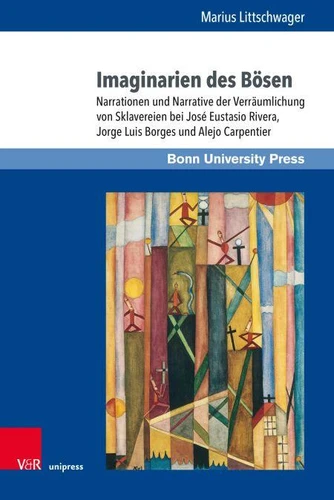Imaginarien des Bösen. Narrationen und Narrative der Verräumlichung von Sklavereien bei José Eustasio Rivera, Jorge Luis Borges und Alejo Carpentier
Par :Formats :
Disponible dans votre compte client Decitre ou Furet du Nord dès validation de votre commande. Le format PDF est :
- Compatible avec une lecture sur My Vivlio (smartphone, tablette, ordinateur)
- Compatible avec une lecture sur liseuses Vivlio
- Pour les liseuses autres que Vivlio, vous devez utiliser le logiciel Adobe Digital Edition. Non compatible avec la lecture sur les liseuses Kindle, Remarkable et Sony
 , qui est-ce ?
, qui est-ce ?Notre partenaire de plateforme de lecture numérique où vous retrouverez l'ensemble de vos ebooks gratuitement
Pour en savoir plus sur nos ebooks, consultez notre aide en ligne ici
- Nombre de pages256
- FormatPDF
- ISBN978-3-8470-1618-2
- EAN9783847016182
- Date de parution10/07/2023
- Protection num.pas de protection
- Taille6 Mo
- Infos supplémentairespdf
- ÉditeurV&R Unipress
Résumé
»Imaginarien des Bösen« befasst sich mit der räumlichen Darstellung des Bösen in ausgewählten Werken von José Eustasio Rivera, Jorge Luis Borges und Alejo Carpentier. Die Untersuchung zielt auf eine kulturwissenschaftlich und narratologisch ausgerichtete Kritik der Annahme einer Ästhetik des Bösen. In den modernen Literaturen Lateinamerikas (hier mit Blick auf spanischsprachige Autoren) gibt sich vielmehr eine postkoloniale Figuration des Bösen zu erkennen, die das Böse über Verräumlichungen kolonialer Sujets fiktional ausgestaltet narrativ vermittelt.
Die Bezugnahme auf Formen der Sklaverei und ihre literarischen Modellierungen sind das Charakteristikum dieser modernen Literatur, die die Geschichte(n) Lateinamerikas als Verflechtungsgeschichte Amerikas erzählt. "Imaginaries of Evil" deals with the spatial representation of evil in selected works by José Eustasio Rivera, Jorge Luis Borges, and Alejo Carpentier. The study aims at a critique of the assumption of aesthetics of evil, oriented towards cultural studies and narratology.
In the modern literature of Latin America (here with a view to Spanish-language authors), a postcolonial figuration of evil can be discerned, which narratively conveys evil through the spatialization of colonial subjects in a fictionalized form. The reference to forms of slavery and their literary modeling are the characteristics of this modern literature, which tells the history(s) of Latin America as a space of entanglements.
Die Bezugnahme auf Formen der Sklaverei und ihre literarischen Modellierungen sind das Charakteristikum dieser modernen Literatur, die die Geschichte(n) Lateinamerikas als Verflechtungsgeschichte Amerikas erzählt. "Imaginaries of Evil" deals with the spatial representation of evil in selected works by José Eustasio Rivera, Jorge Luis Borges, and Alejo Carpentier. The study aims at a critique of the assumption of aesthetics of evil, oriented towards cultural studies and narratology.
In the modern literature of Latin America (here with a view to Spanish-language authors), a postcolonial figuration of evil can be discerned, which narratively conveys evil through the spatialization of colonial subjects in a fictionalized form. The reference to forms of slavery and their literary modeling are the characteristics of this modern literature, which tells the history(s) of Latin America as a space of entanglements.
»Imaginarien des Bösen« befasst sich mit der räumlichen Darstellung des Bösen in ausgewählten Werken von José Eustasio Rivera, Jorge Luis Borges und Alejo Carpentier. Die Untersuchung zielt auf eine kulturwissenschaftlich und narratologisch ausgerichtete Kritik der Annahme einer Ästhetik des Bösen. In den modernen Literaturen Lateinamerikas (hier mit Blick auf spanischsprachige Autoren) gibt sich vielmehr eine postkoloniale Figuration des Bösen zu erkennen, die das Böse über Verräumlichungen kolonialer Sujets fiktional ausgestaltet narrativ vermittelt.
Die Bezugnahme auf Formen der Sklaverei und ihre literarischen Modellierungen sind das Charakteristikum dieser modernen Literatur, die die Geschichte(n) Lateinamerikas als Verflechtungsgeschichte Amerikas erzählt. "Imaginaries of Evil" deals with the spatial representation of evil in selected works by José Eustasio Rivera, Jorge Luis Borges, and Alejo Carpentier. The study aims at a critique of the assumption of aesthetics of evil, oriented towards cultural studies and narratology.
In the modern literature of Latin America (here with a view to Spanish-language authors), a postcolonial figuration of evil can be discerned, which narratively conveys evil through the spatialization of colonial subjects in a fictionalized form. The reference to forms of slavery and their literary modeling are the characteristics of this modern literature, which tells the history(s) of Latin America as a space of entanglements.
Die Bezugnahme auf Formen der Sklaverei und ihre literarischen Modellierungen sind das Charakteristikum dieser modernen Literatur, die die Geschichte(n) Lateinamerikas als Verflechtungsgeschichte Amerikas erzählt. "Imaginaries of Evil" deals with the spatial representation of evil in selected works by José Eustasio Rivera, Jorge Luis Borges, and Alejo Carpentier. The study aims at a critique of the assumption of aesthetics of evil, oriented towards cultural studies and narratology.
In the modern literature of Latin America (here with a view to Spanish-language authors), a postcolonial figuration of evil can be discerned, which narratively conveys evil through the spatialization of colonial subjects in a fictionalized form. The reference to forms of slavery and their literary modeling are the characteristics of this modern literature, which tells the history(s) of Latin America as a space of entanglements.



